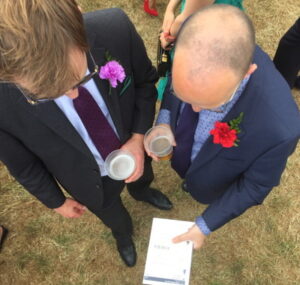 The world of horse racing is one that is easily accessible if all you want to do is place a quick bet. As long as you understand the basics of placing a wager with a bookmaker, you can look at the line-up of a race and either go with your instinct or else use research to point you in the right direction.
The world of horse racing is one that is easily accessible if all you want to do is place a quick bet. As long as you understand the basics of placing a wager with a bookmaker, you can look at the line-up of a race and either go with your instinct or else use research to point you in the right direction.
If you want to become more involved in horse racing, however, then you might start to find yourself greeted by aspect of the industry that can be quite confusing. What is the ‘Going’ that people refer to, for example? Why might that affect the way the horses run?
The more that you invest in your following of horse racing, the more you’ll begin to get out of your experience. That fact is never more accurate than when you begin to delve into what’s involved in a race card.
If you’ve never looked at one before, or even just haven’t looked that closely, then you might wonder what on earth all of the symbols and signage is referring to. Ordinarily you might want to just forget all about it and not bother, but, as you’ll learn reading this, it can tell you quite a lot about the various races that are taking part that day and that in turn might lead you to pick a winner or two.
What Is In A Race Card?
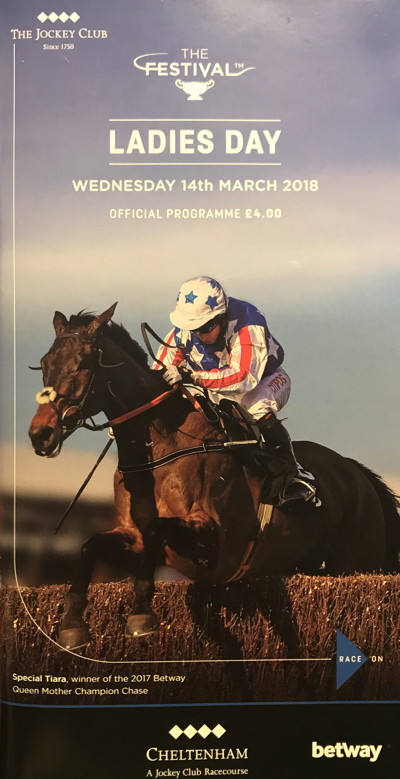 In this section I am going to talk about how to read a traditional race card, like those printed at a race track. The same principle applied to digital race cards you will often find directly on a betting site or through a site like the Racing Post.
In this section I am going to talk about how to read a traditional race card, like those printed at a race track. The same principle applied to digital race cards you will often find directly on a betting site or through a site like the Racing Post.
Some betting sites are far better at giving you information and stats, with some providing far more than a standard race card and others that provide little more than the race name, time, runners, riders and odds. If you are looking for a good horse racing bookie with very good stats and information head over to our horse racing guide where we provide recommended sites to bet with for coverage.
In the old days race cards were exactly that, cards that contained race information for that meeting. Few racecourses actually produce cards any more. Instead, you’ll find that the race card you buy from the people selling them around the venue are actually booklets or programmes, not dissimilar to those that you might buy in the theatre.
Inside you’ll find a whole heap of information, but you’ll also see countless adverts for both national companies and ones that are based more locally. The event that you’re attending will dictate how many adverts there are and what they’re for.
In terms of the information you’ll discover on the outside of your race card, the following is the sort of thing that’s typically on there:
- The name of the racecourse
- The date
- The Meeting
You might also find some race cards list the races that are taking place during the day, with rough start times also included. You might attend on Day One of the Grand National Festival, say, so you could have a race card that has the following writing on it:
- Aintree Racecourse
- 14th April
- The Grand National Ladies Day
Having read information that you’ll almost certainly already know, such as where you are and what day it is, you’ll then want to open the race card and see what else you can find out. Aside from the aforementioned adverts for companies, the inside of a race card contains key information that might be useful for you when you’re looking to place your bets.
The best race cards will often give you a short history about the racecourse itself. Don’t ignore this, even if it seems irrelevant. There can often be nuggets of information in there that can tell you something about the type of horses that have tended to well historically. You can also find out how the course has developed over the years. Has the course layout been changed recently, for example? If so, some horses, perhaps even jockeys, might not be used to it and that might change how they perform.
The Race List
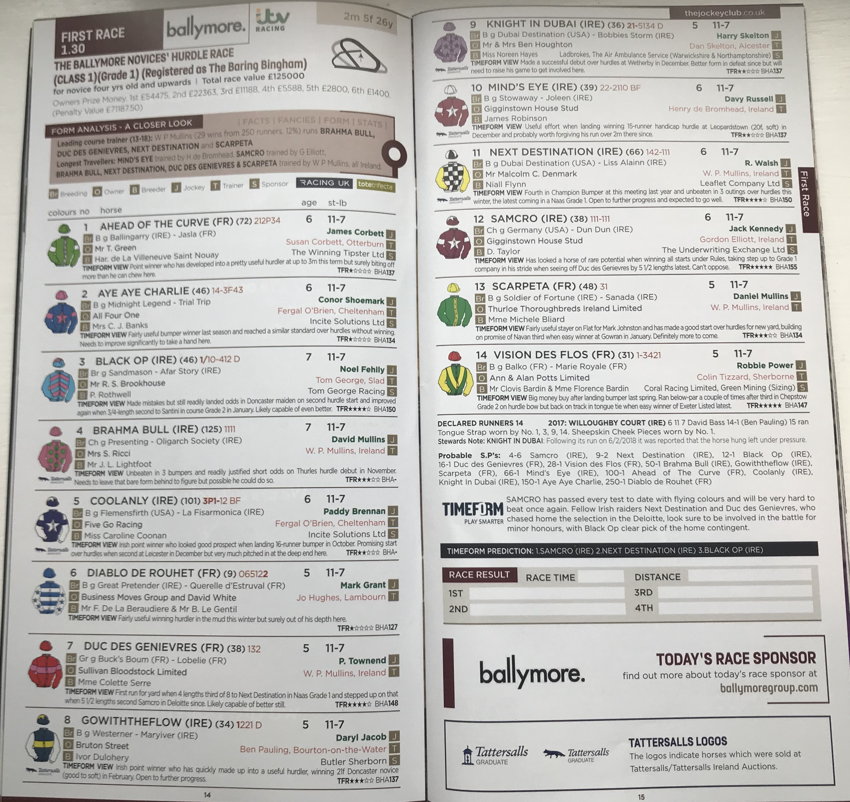
The most important thing you’ll want to read through in a race card is the list of the races themselves. They are all separated out by what is known as a Header, which is the name of the race, complete with any sponsor, written in bold.
As an example, a race from the Grand National in 2018 would’ve looked like this in the Header:
2.50pm – Betway Bowl Chase (3m210y) – Grade 1
You’ll note that the Header also includes the length of the race and the Grade/Group/Class that it’s run at. Beneath the title and time of the race is often information about the horses that are entitled to run in it.
That might look something like this:
(5yo+ 0-140)
As you might have worked out if you’ve got any real knowledge of horse racing, that means that the race is for horses aged five and over with a rating of between zero and one hundred and forty.
Finally, the Header will usually tell you how much money the winner will get, how many horses were scheduled to take part in it, what the going is like and the TV channel it’s on if it’s being televised. Some race cards may put the length of the race here instead of in the top of of the Header.
Presuming they don’t, it will look like this:
Winner: £106,647 – Runners: 8 – Going: Good To Soft – Channel: ATR
ATR, if you’re wondering, stands for At The Races. The information about the number of horses and the Going will have been correct at the time that the race card went to print, but that might not be accurate on the day.
Many punters don’t bet huge amounts of money on the first race unless they’re confident that they’ve got a winner, instead waiting to see how the Going is for the first race and then adjusting their bets accordingly.
The Going
Having mentioned it numerous times, it’s only fair to explain what the ‘Going’ is and how it might affect the outcome of a race. It refers to how the ground is, with numerous different options available:
- Hard to Firm
- Good to Firm
- Good
- Good to Soft
- Soft
- Heavy
Which one of these options the Going falls into will change how easy or otherwise it is for different horses to run on it. The Going is dictated by the weather, with large rainfall often causing is to be Heavy or Soft.
One thing you’ll want to do is keep an eye out for whether or not horses in a race have a history of running well in a given type of Going. Those that favour it when the Going is Good will not be a fan of it when it’s Heavy, for example.
Details About The Race
The next thing you’ll find on the race card is a series of details about the race. Don’t be overwhelmed by it, even it does look quite complicated when you first see it. The key thing to do is to break it down and it will become easier.
Here’s how it will often look:
£190,000 guaranteed – For: 5yo+ Fillies and Mares Rated 0-140 – Minimum Weight: 11-7 – Penalties: After March 10th, each Hurdle won 7lb – TopRatedHorse Handicap Mark: 120 – Entries: 8 – Penalty Value 1st: £106,647 – 2nd: £14,729 – 3rd: £10,043.33 – 4th: £8,172.65
The first thing in the list is telling you that the race has a guaranteed prize pot of £190,000. Then there’s a breakdown of the types of horses that are invited to take part in the race, which in this case involves any fillies and mares that are over five-years-old.
After the horse type comes the minimum weight, along with any penalties applied to horse that, in this instance, have won a hurdle race after the tenth of March. If they have, they’ll have to carry an extra seven pounds.
One of the key bits of information tucked in there is the rating of the top horse taking part in the race, in this case TopRatedHorse’s rating is one hundred and twenty. The number of horses entered into the race when horses could first be entered will be on there, though this is likely to change by the time it actually gets underway.
Finally, ‘Penalty Value’ is a bit misleading as it actually refers to the amount of money the horses finishing in the top four positions will receive.
Details About The Jockey And Trainer
This is the point of the race card at which the least enthusiastic might start to get a little bit bored. If you stick with it, however, then you’ll be in a decent position to pick up some really useful information. Race cards will show you information on every horse taking part in a race, including details on the jockey riding it and the trainer who has got it ready for the race.
The best race cards as those printed in colour as they will have a clear imagine of the Silks worn by the jockeys. This can be crucial when you’re actually watching the race, helping you to avoid cheering on the wrong one. You’ll also see the number of the horse, which is worth looking out for if a couple of the Silks look quite similar. The horse’s name will be printed in bold, whilst in brackets it will say something like (GBR) or (IRE) to indicate where it was born. Decent race cards will also inform you about the number of days since the horse last raced.
In a race card for the biggest races you’ll almost certainly find a photo of the jockey, plus their name. Some jockeys will have a number next to them, which is the amount of weight that they’re allowed to reclaim from any starting weight applied to a horse. It will usually be in pounds. You should also see the name of the horse’s trainer.
Information About The Horse
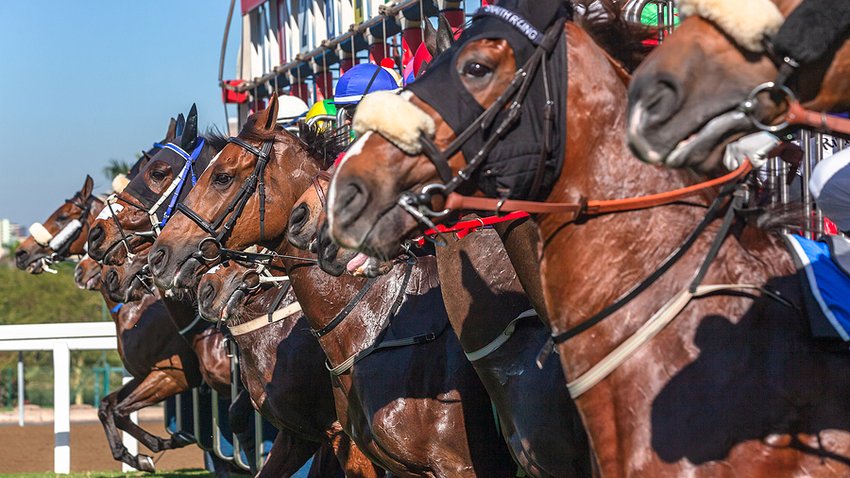
The information about both the jockey and the trainer might be helpful if they have a relationship with the racecourse you’re at and have won on it in the past, but it’s not as useful as the information you’ll be able to source on the horse if you know what you’re looking for.
There are a number of things that you’ll find on the race card about the horse, usually denoted by single letters. The colour and sex of the horse are the first things to look out for and will appear like this:
- Ch – Chestnut
- Gr – Grey
- B – Bay
- Br – Brown
- g – Gelding
- f – Filly
- m – Mare
- c – Colt
- h – Horse
You’ll note that the colour has a capitalised letter, whilst the sex is lower case. You might also see three other horse names and wonder what on earth they’re about. They are indicative of the horse’s family history, normally showing the father (Sire), mother (Dam) and maternal grandfather (Damsire).
Given the importance of a horse’s genealogy in horse racing, this is something worth making a note of – especially if you recognise any of the names.
Previous Form
Arguably the most important section of the entire race card, at least when it comes to you figuring out what bets you should place, is the section on each horse’s previous form.
As with other parts of the card, it can look a bit like it’s written in code if you don’t know what it all means.
It might look something similar to this:
14-Pd2
The horse’s most recent race comes at the end of the list, with numbers representing where it finished in the race. The letters, meanwhile, all stand for something and it’s important to look at whether they’re uppercase or lowercase as that makes a difference. The only symbol in the above form example that doesn’t refer to a race finish is the – symbol, which means that it was the turn of the year. Some race cards will display that as / instead.
Anyway, here’s what the letters stand for:
- F – Fell
- R – Refused
- d – Disqualified
- O – Unplaced
- B – Brought down
- U – Unseated rider
- P – Pulled up
In the above example, the horse won, came fourth, the new year kicked in, it was Pulled Up, disqualified and then, most recently, finished second. There can be other letters that are indicative of the course and race specifically.
They are as follows:
- CD – Has won over the course and distance in the past
- BF – The horse was a favourite for the race in the past but was beaten (hence Beaten Favourite)
- C – Has won on that course in the past
- D – Has won over that distance in the past
The information doesn’t stop there, with the horses Silk also written out in words. This is especially useful in cases when the race card is in black and white rather than colour.
It might say something like this:
RED, WHITE squares, RED cap
Comment, Information, Timeform
Underneath all of the information about the horse that might provide you with some context about their previous performances, you’ll find something variously referred to as the ‘Comment’, ‘Information’ or ‘Timeform’. Timeform is actually a company that provides analysis of a horse’s chance of winning, so ‘Comment’ or ‘Information’ tends be used in its stead if the racecourse, bookmaker or betting site you’re at doesn’t have a deal with said company.
The important thing to remember is, whatever name its given in the race card you’re reading, this is an opinion on the horse according to those in the know.
It’s the equivalent of having a chat with a trainer about what they think of the various chances of each horse and they’ve summed it up in the form of a sentence along the lines of:
Struggled at this distance last time out, but performed well here two years ago. Is better when the Going is good.
Along with the description from Timeform, or whoever it is that’s doing the Comment, you’ll also find a Star Rating that explains the horse’s chance of winning.
They break down, roughly, as the following:
- Five Stars – Considered to be one of the favourites to win
- Four Stars – Likely to place or even to challenge the eventual winner
- Three Stars – Better horses are running but has a slight chance
- Two Stars – Not likely to win but might if everything falls into place
- One Star – Virtually no chance of winning. Regardless of odds, this is a long-shot
When it comes to picking your horses, you’ll want to use a combination of looking at the odds, the Comment, the Star Rating and other factors.
Considering the horse’s form as well as how they’ve done on the course you’re at will give you a real chance of picking a winner.
Horse BHA Rating
The final thing that you’ll see in the race card and will want to take into account is the horse’s BHA Rating. This is an official racing that is assigned to each horse by one of the handicappers that works for the British Horse Racing Authority – hence the acronym. Each individual horse has to have taken part in enough races to give the handicapper a fair chance of assessing them correctly.
Handicap races see horses given an extra amount to carry – their handicap – in accordance with their BHA Rating. Horses carry one pound less than the horse higher than it with a rating, per number beneath them. Let’s look back at our TopRatedHorse from earlier and their rating of 120. As they’re the best horse in that race, if the next horse was rated at 119 then they would carry 1 lb less than TopRatedHorse. If they were rated as 115 then they’d carry five pound less and so on.
One thing you’ll want to be aware of is the fact that non-handicap races don’t see horses carry extra weight, but the BHA Rating will indicate how the horse was rated when it was initially entered into the race. When it’s a horse that’s running a steeplechase for the first time, usually in a novice race, the Rating will be based on how they did when they ran in hurdles races and will have a lowercase ’n’ next to it.
About The Race
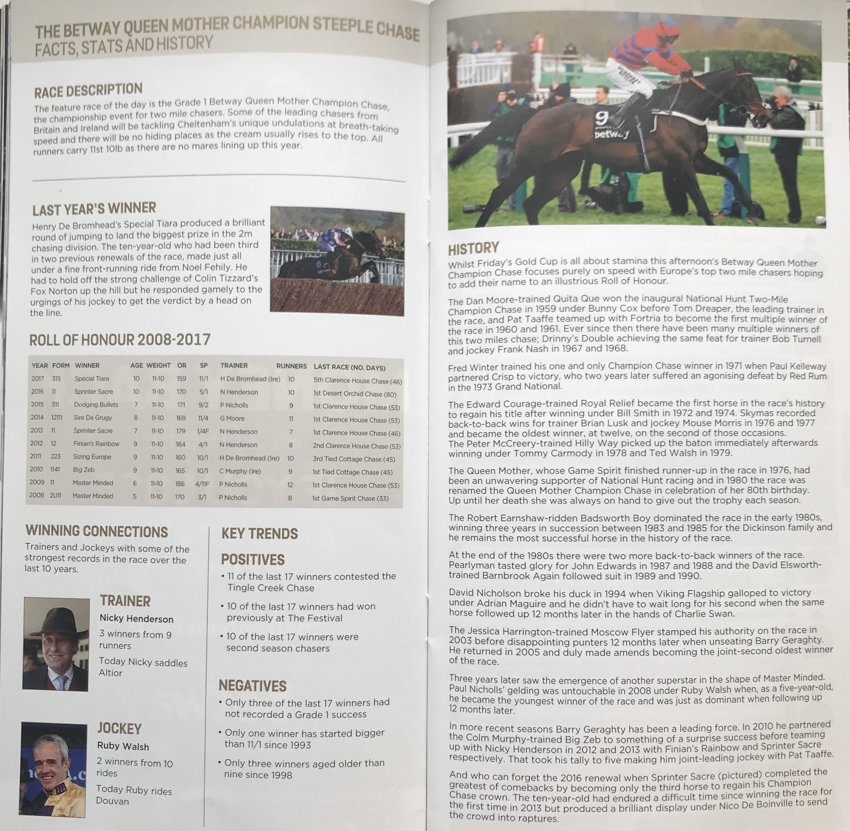
Usually for bigger races there will be a full history along with facts, descriptions and other information.
These additional pages can often contain lots of little details that can help you make decisions, especially if you still can’t decide between your runners after reading the main card.
Example Of A Full Race Card

Now that you know what the race card’s various sections mean, let’s see a rough example of how that might look when you put it all together:
2.50pm – Betway Bowl Chase (3m210y) – Grade 1
(5yo+ 0-140)
Winner: £106,647 – Runners: 8 – Going: Good To Soft – Channel: ATR
£190,000 guaranteed – For: 5yo+ Fillies and Mares Rated 0-140 – Minimum Weight: 11-7 – Penalties: After March 10th, each Hurdle won 7lb – TopRatedHorse Handicap Mark: 120 – Entries: 8 – Penalty Value 1st: £106,647 – 2nd: £14,729 – 3rd: £10,043.33 – 4th: £8,172.65
TopRatedHorse Ch m 14-Pd2 BF
PICTURE OF SILK RED, WHITE squares, RED cap
Struggled at this distance last time out, but performed well here two years ago. Is better when the Going is good. ****
BHA Rating: 120
It should go without saying, but race cards will differ according to the choices made by the racecourse owners and even the editor of the race card itself. You’ll need to bear that in mind when you’re looking through the race card in order to understand what’s going on, but as long as you’ve got this guide to make reference to you’ll be fine.
The race card might seem like a frivolous thing that makes the world of racing even more confusing to understand than it already is, but in reality it can be a wealth of information if you’ve taken the time to understand what might otherwise appear as code. Horse racing isn’t as oblique as you might fear, so you’ll be able to give yourself an advantage over the average punter now that you know what a Br c that has 12-1F4 in the past means.
Online vs Printed Race Cards
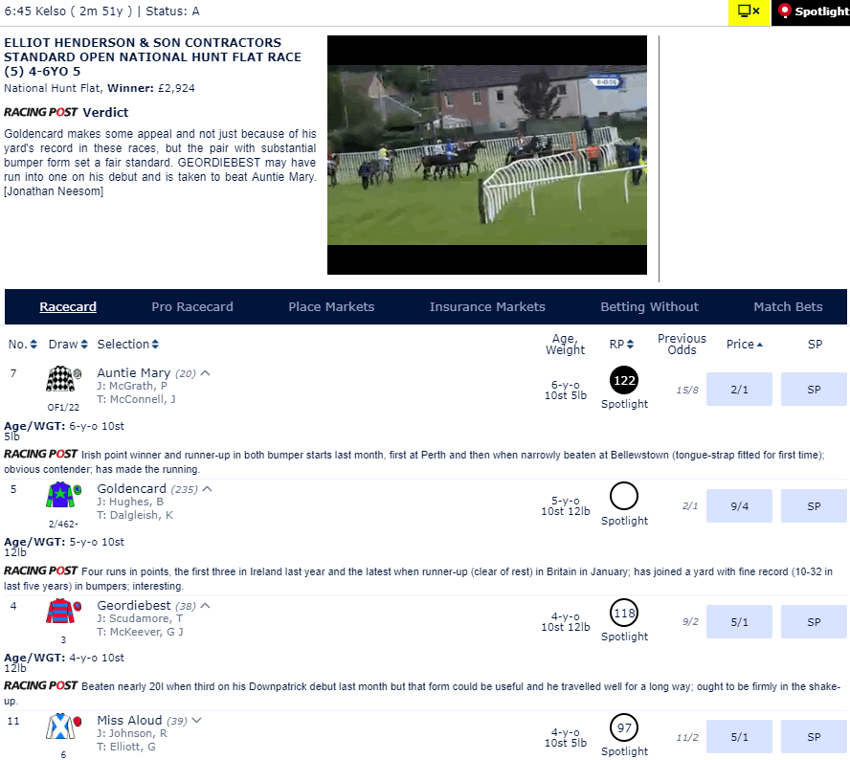
There are benefits and disadvantages to reading a race card in a booklet vs online, although in reality they all contain the same basic information, often just packaged differently.
If you are going to attend a race meeting you would of course most likely use a race card from the programme or from a newspaper, then again I see more and more people using their phones at tracks to access race information. People who bet in shops often prefer to use newspapers too, with racecards still often stuck up on the walls of the bookmaker shop. Of course if you are betting online you might use a newspaper but in all likelihood you will just access the information digitally.
A big benefit to a printed card is being able to edit it yourself, such as circling your runners or key stats for later betting. You can also access the information at any time, especially good if you can’t get a reliable internet connection, which can often happen at busy meetings. Of course you can also keep a racecard, which is great for those that like mementos from the events they have attended.
The biggest benefit of accessing a racecard online is the information is more up to date, this is particularly useful for late non-runners, last minute jockey changes, etc., and most importantly up to date odds. The depth of content is also generally far better, with online cards it is often possible to click individual horses, jockeys and trainers to obtain a more detailed history of the runners and riders. For most people the information in a standard card is plenty, but for many avid punters they depth available online is far superior.
Most big online bookmakers now provide not just a full race card but also let you access detailed results and form history for runners and riders, as well course information. If you are going to bet using more than just the name, odds or colours of a horse then it really makes sense to take advantage of this info. Bookmakers often pay a lot in fees to get access to these stats and therefore they tend to make it very easy to access and understand for the user. Again if you would like to know which bookies are best for detailed racing information then head over to our horse racing page where we recommend the best sites for stats, news, streaming, odds and results.